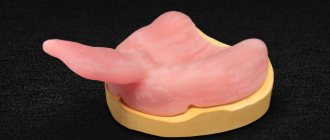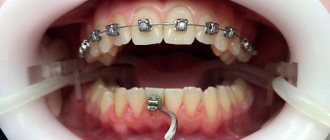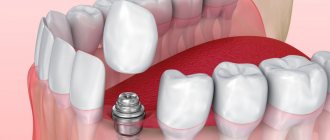- Material for making dentures
- Cost of dental prosthetics
- Make a denture in Moscow
Prosthetics is one of the most popular orthopedic services in dentistry.
The dental laboratory Denta Labor offers the manufacture of dentures, giving the smiles of its patients impeccable beauty. Accurate dentures made from modern materials: improve the aesthetics of a smile and the patient’s self-esteem, fully restore the functions of the oral cavity, and help eliminate barriers to communication.
Through the efforts of our specialists, prosthetics are made that are indistinguishable from real teeth. Their service life is more than one year. They do not rub when worn, are comfortable and practical, and do not require complex care.
Indications for prosthetics
As already noted, prosthetics are recommended to be performed with fixed dentures. Because they are more convenient and reliable. But is it possible to put a removable denture on 1 tooth? Of course, there are practically no contraindications here. The main list of conditions when the need for removable monoprosthetics arises is as follows:
- missing 1 tooth along with the root,
- the natural crown is completely destroyed, but the root is healthy and is being “prepared” for fixation of the stump tab with a crown: during the waiting stage, a removable denture is worn,
- an implant has been installed, but the crown has not yet been fixed on it: the healing (fusion with the bone) of a single implant can last 3-6 months, so a plug is placed on it and the gum is sutured. During this period, a temporary prosthesis is installed for aesthetics and to protect the gums from injury.
The exception is patients with absolute contraindications to fixed prosthetics or implantation. For example, in case of severe diseases of the body, poor blood clotting, intolerance to anesthesia, in childhood, during pregnancy and lactation, the “removal device” is worn for a long time on an ongoing basis.
There are certain indications for installing a removable denture on one tooth, which depend on the type of orthopedic design. Therefore, we will dwell on them in the appropriate sections.
Examples of prostheses made in our laboratory
Thermoplastic (clasp) "Quattroti".
ACRY FREE (acrylic free).
Nylon removable denture.
The article was checked by: Meleshkin Dmitry Vladimirovich
If you liked this post, share it with your friends and subscribers.
What problems can be avoided?
Let's consider what problems can be solved when using prosthetics with a removable orthopedic design:
- the aesthetics of the smile is restored,
- the gums in the area of the row defect (missing tooth) are protected from injury by hard pieces of food,
- bite relationships and occlusion are preserved: therefore, the antagonist (opposite from above or below) does not move down or up,
- neighboring teeth are not so overloaded during chewing,
- The teeth adjacent to the defect do not move: if you leave a “gap” in the row and do not perform prosthetics, then the “neighbors” on the right and left will gradually shift towards it. Thus, in the future it will be difficult to install a prosthesis or even have to wear a brace system.
Insert ceramic teeth
Inserting ceramic teeth will be the right decision if you need to restore your front teeth, which are clearly visible when communicating with people around you. But for the restoration of chewing teeth, ceramic crowns are not suitable: ceramics is a fairly fragile material and a crown made from it may not withstand the heavy load that is constantly placed on the chewing teeth when chewing food.
The high aesthetics of ceramic crowns determines the expensive prices for this type of orthopedic structures. But the patient gets a beautiful and natural smile: you can also evaluate the results of dental restoration with ceramic crowns from the photos that we have posted below. Ceramic crowns can be placed on both the abutment tooth and the implant.
Types of orthopedic structures
A removable denture for one tooth can be of 2 types - an immediate prosthesis or “butterfly” and a splinting clasp. They belong to partial orthopedic structures, because placed in case of partial edentia. They are placed in certain clinical situations and have different appearance (as well as purpose). Let's consider their features further.
Don't know what type of prosthetics to choose?
We will help in the selection, advise where to read more information and compare types of prosthetics.
Consultation with an orthopedic doctor in Moscow clinics is free! Call now or request a call
Working hours: from 9:00 to 21:00 - seven days a week
Immediate prosthesis or “butterfly” - characteristics, pros and cons
“Butterfly” is a removable denture for 1 tooth, which looks like a dental crown with pink “wings” or hooks on the sides (4 hooks in total). How does such an orthopedic structure hold up? With these hooks, otherwise called “clasps,” the prosthesis covers the adjacent supporting teeth and is thus fixed. The crown is made of light-colored plastic, and the hooks, which are a continuation of the base, are made of elastic or hard pink polymer. Based on the material from which the artificial gum is made, acrylic and nylon dentures for 1 tooth are distinguished. Moreover, both classic acrylic and the more modern monomer-free material Acry-free (“Acry-free”) can be used.
- indications: suitable for all groups of patients, but only if there are included row defects,
- an absolute contraindication is a terminal defect - the absence of the last molar in the row: in this case, the butterfly clasps on one side will have nothing to attach to,
- advantages: quickly manufactured, easy to install, quick adaptation,
- Disadvantages: the hooks quickly stretch, the fixation of the structure becomes worse - you have to use a special adhesive cream or change the product. Chewing function is not restored very well. They do not stop bone tissue atrophy under the crown (where there is no root). Without load, the bone decreases in size and sags, causing discomfort and decreased aesthetics.
Another contraindication is too young age (up to 2-4 years) and the presence of mental illness, epilepsy. In such situations, the patient may unknowingly swallow the structure.
Read on the topic: immediate dentures - what they are, types, advantages and disadvantages.
Clasp splinting – features, pros and cons
A clasp denture with a splinting function is similar to a traditional one in that a metal arch is placed inside its base - this frame imparts rigidity, facilitates chewing food and correctly distributes the load. Additionally, the design includes claw-shaped or ring-shaped processes made of metal, occlusal pads, with the help of which splinting of mobile teeth occurs. In the upper jaw, this design does not have a massive palatal overlap, but only a thin plate or bridge.
- indications: used for included and end defects, but only in the presence of mobility of the remaining teeth (with periodontitis and periodontal disease),
- advantages: they perform 2 functions at once - they restore missing teeth and stabilize remaining teeth. They distribute chewing pressure well, it is much more convenient to chew with them than with “butterflies”,
- disadvantages: large mass of the structure, does not stop the atrophy of the jaw bone.
How are dental implants inserted?
Implantation, in order to insert teeth, can be carried out in different ways: according to a one-stage or two-stage protocol. But its essence will always boil down to the following: in order to insert a lost tooth, the doctor will implant a special structure in the patient’s jaw - an implant, on which he will subsequently install a crown or prosthesis.
Until the stage of permanent prosthetics, you will walk with a temporary prosthesis, which is placed during one-stage implantation immediately after implantation. In two-stage implantation, immediate dentures are used to mask dentition defects.
A permanent crown or prosthesis is placed on the implant only after it has completely fused with the natural bone tissue of the jaw. Crowns for installation on an implant can be made from any material: for the restoration of front teeth, ceramic crowns are most often used, for the restoration of chewing units - products made of zirconium and metal-ceramics.
Which implantation technology should I choose to insert teeth? It is impossible to give any absentee recommendations on this matter. You need to visit the clinic, undergo an examination and diagnosis, and only after that the implantologist will offer you the optimal implantation method.
Rules for care and wearing
How to wear a mono-prosthesis? Removable “butterflies” require regular removal - after each meal or even eating thick yogurt, the orthopedic structure will have to be removed from the mouth and washed in water. There is no need to remove the splinting “clasps” every day; by the way, this can even be dangerous, because there is a risk of severe loosening. With any denture option, you will have to carefully observe oral hygiene - brush and paste twice a day, and soak the denture in a disinfectant solution once a week. You will have to visit the dentist approximately 1-2 times a year for examination and relocation of the structure, because... due to bone atrophy, the fit of the base becomes less dense.
Dietary recommendations limit and even prohibit the consumption of hard foods - chunky hard meat, fresh hard vegetables and fruits (you have to grate them first), toffees and toffees. Therefore, the “butterflies” are weakly fixed and can fly off, and the teeth under the splinting clasps can become very loose.
Manufacturing of removable dentures
Prosthetics with various types of dentures has been used in clinical practice for decades, so dentistry has a well-functioning production mechanism.
Stages of manufacturing a partial removable denture
- Initial consultation, examination of the oral cavity and selection of orthopedic design.
- Taking impressions and producing a wax model in the laboratory.
- Grinding and correction of the finished structure.
- Finishing the structure in the articulator and trying on the wax structure by the patient.
Although the production of a partial denture takes on average 2 weeks, the adjustment period can last up to a month. At this time, the patient may feel some discomfort, but if the prosthesis causes significant pain and discomfort, it is worth contacting a specialist for correction or replacement of the structure.
Which option to choose among removable ones?
Which prosthesis[1] should I put on one tooth? It is recommended to select the best option individually, together with an orthopedic dentist. If the speed of prosthetics is important, and the supporting teeth do not have pathological mobility, then it is better to choose a “butterfly” made of acrylic or “Acry-free” for the chewing part of the row. Nylon, of course, is comfortable, but for a very short time, and a stretched product will have to be changed soon. In the presence of pathological mobility, only the splinting clasp remains.
But do not forget that all the options considered are recommended for temporary use only. They are not very securely fixed (especially in the “smile zone”, where the supporting crowns are not so wide) and do not stop bone tissue atrophy. Therefore, it is better to turn to alternatives.
“I wore a bow tie during pregnancy until I could get an implant. It’s not very convenient, and you have to constantly clean it. But I was afraid that without a prosthesis, neighbors would move towards each other, and I would generally suffer later. I was afraid that it would fall out while eating and I would swallow it. Therefore, I had to chew very carefully.”
Olga R., review from baby.ru
Stages and timing of dental prosthetics
The specific plan and order of all dental prosthetic measures in each individual case may be different, depending on which teeth are to be restored, what technology is chosen, etc. Any procedure always begins with an examination of the patient, assessment of the condition of the dentition and the necessary diagnostic procedures.
After this, the doctor, together with the patient, develops a detailed treatment plan. The stages of dental prosthetics may include grinding down teeth - to install veneers or crowns, or to fix a bridge or clasp prosthesis. Another important stage is taking impressions, from which the dental technician will make crowns or dentures.
The accuracy of the fit of the prosthesis and the ease of use in the future depend on the quality and accuracy of this procedure and the choice of the most suitable material. In order for everything to be done with the utmost precision, jaw modeling programs are used, the work of the jaw joints and muscles is revealed, and the closure of the teeth of the upper and lower rows is studied.
A mandatory stage of the dental prosthetics process is the manufacture of the prosthesis in the laboratory. This is labor-intensive jewelry work, the quality of which determines how successful the fitting of the design will be, whether adjustment is needed, how comfortable the use of the prosthesis will be for the patient, how quickly one can get used to it and how long the system will last.
After the prosthesis is made, it is tried on, modified if necessary, and then fixed. Very often, before installing a permanent option, which may take several months, the patient is given temporary structures, which will need to be dismantled before installing a permanent structure. And finally, after installation of the prosthesis, there is an adaptation period.
In the case of prosthetics on implants and installation of anatomically accurate structures, adaptation takes a matter of days. When installing complex and removable bridges, getting used to it can take a month. In general, it is simply impossible to say in advance how long prosthetics will take. This can only be determined by a doctor after examining a particular patient and choosing the surgical technology.
Preparing teeth for the procedure
Before the procedure, it is necessary to carry out a number of activities, which can take from one to several months. In particular, you will need to carry out professional oral hygiene and cure all your teeth. It may then be necessary to remove non-restorable teeth and their roots, and sometimes also to correct the bite or position of the teeth using braces.
If implantation is planned, it may require bone grafting. Therapeutic preparation of teeth for prosthetics includes complete sanitation of the oral cavity - professional cleaning, removal of tartar, treatment of caries and periodontitis, depulpation of those teeth that cannot be cured in any other way and those that are intended for grinding to fix dentures.
The surgical preparation stage involves the removal of severely damaged and incurable teeth, removal of soft and hard tissue pathologies, bone augmentation before implantation (for example, sinus lift), as well as the implantation operation itself. The orthodontic and orthopedic stages involve correcting the bite and straightening the teeth using braces.
This is important not only for beauty, but also to ensure that the load after installation of the prosthesis is distributed evenly - the health of the remaining teeth and the service life of the prosthesis depend on this. Protruding teeth are also sharpened and secondary deformities are corrected. All stages of preparation are extremely important and directly affect the quality of the procedure, ease of use of the prosthesis and its durability.
Selecting a method
Which dental prosthetics to choose in a particular case is determined by the nature and scale of dental defects - how many and what teeth are missing, how healthy the existing teeth are and what methods need to be used for their treatment and restoration. This will also require the necessary diagnostics - x-rays, tomography, laboratory tests, studying the patient’s health status.
Of course, the patient’s requirements play an important role - what result is needed and what financial capabilities he has. Some patients are willing to wait several months, while others need urgent prosthetics. Some agree to implantation, while others are contraindicated for medical reasons. In each specific case, the choice of technique and procedure plan is a compromise between desires and capabilities.
How are dentures made?
The manufacture of the prosthesis itself does not greatly affect the time of dental prosthetics - it takes only a few days. Much more time is spent on preparatory procedures, waiting for implants to heal, and adaptation to the finished structure.
After impressions are made and digital 3D models of the jaw are created, the impressions are transferred to plaster casts in the dental laboratory. Subsequently, structures made of titanium, zirconium dioxide, various alloys, and polymer materials are created using special equipment. Ceramic crowns require firing and sometimes painting. Installation of a finished structure
The manufactured prosthesis must be tried on. If the fit is incomplete or inaccurate, the doctor corrects it or sends it to the laboratory. If it fits perfectly, the doctor fixes it in the oral cavity. Correction may be required in the future due to changes in the tone of the masticatory muscles, malocclusion, and bone tissue atrophy due to the lack of chewing load on the bone.
Next, the doctor instructs the patient how to use the denture - what can be chewed and what cannot, how often and thoroughly should be cleaned, when to come for an appointment to inspect the structure, professional cleaning, and, if necessary, repair or replace components.
How are dentures attached if the last supporting teeth are missing?
If we mean a complete absence of teeth, then various types of complete prosthetics, which we discussed above, are suitable. If the teeth are preserved, for example, in front and we are only talking about restoring the lateral chewing teeth, then it is possible either clasp prosthetics on implants (which will provide the necessary support for the prosthesis), or the installation of removable dentures made of acrylic or nylon, or clasp prosthetics with support on the front ones teeth.
Alternatives – fixed dentures and implantation of 1 tooth
If you choose among temporary dentures for one tooth, then the best alternative option is an adhesive fixed bridge. Visually, this is a crown with two small “wings” on the sides that are glued to the supporting teeth. Most often it is placed on the upper or lower front teeth, because in the chewing areas there is too much load and the fixing composition will quickly come off. An adhesive bridge is made of plastic or composite composition.
The classics of permanent fixed prosthetics are bridges. Those made from metal ceramics and zirconium dioxide are the most durable, and ceramic ones look very aesthetically pleasing. The service life, depending on the material, is 7-20 years, but there are also disadvantages. For example, for bridges it is necessary to remove the pulp and grind down the adjacent supporting teeth. And the cost of such a restoration is comparable to the best prosthetic option – a crown on an implant. By the way, the latter will not have such a problem as progressive bone atrophy, since only an implant restores the missing tooth root. And in terms of cost, implantation in the economy and even in the middle class is comparable to prosthetics using a classic bridge. And in terms of service life, a crown on an implant lasts 2-3 times longer.
%akc72%
Prosthetics at the clinic "PRESIDENT"
In our clinic you can quickly and effectively restore any number of teeth using advanced equipment and innovative techniques.
We work with leading implants: Implantium, Ankylos, Astra-Tech, Straumann.
Each procedure is preceded by diagnostics (computed radiography and tomography), which eliminates the risk of complications and allows you to choose the optimal method, taking into account the anatomical features and physical condition of the patient.
We offer the most modern and proven recovery procedures:
- prosthetics with implants produced in Israel, Switzerland, Germany, South Korea, Sweden;
- instant implantation – allows you to restore the integrity of the dentition in just one day;
- prosthetics using metal-free ceramic crowns;
- installation of a prosthesis with a crown made of zirconium dioxide or metal ceramics;
- partial removable prosthetics;
- installation of temporary prostheses.
The procedure is as comfortable as possible, without pain or inconvenience. The installed dentures have an attractive appearance and perfectly imitate natural tissues, looking aesthetically pleasing and natural. And you can use them on the day of installation.
Don’t give up your usual lifestyle, don’t hold back your smile, just call and make an appointment at one of our clinics in Moscow!
Cost of dental restoration
How much does a denture cost for one tooth? In Moscow and the regions, the price of an immediate prosthesis averages 6000-7000 rubles, and a splinting clasp prosthesis costs from 60 thousand rubles. Also, before prosthetics, it is necessary to undergo the removal of tartar and plaque, treatment of existing caries, pulpitis, stomatitis - all these procedures are paid separately.
[1] Abolmasov N.G. Orthopedic dentistry, 2002.
Author: Sambuev B. S. (Thank you for your help in writing the article and the information provided)
If you need to insert a tooth after it has been removed
The best solution to insert one tooth is a one-time implantation, but a tooth can only be inserted if too much time has not passed since its removal. To firmly fix the implant in the bone, the jaw bone tissue must be dense and have a certain height. But the longer a tooth is missing, the more the bone thins and dries out. Therefore, if you had a tooth removed several years ago, you can have it replaced either with prosthetics or classical implantation.
Veneers and Lumineers
Veneers and lumineers can be used as aesthetic options for dentures on the front teeth. Veneers are very thin shells of porcelain that are given a color similar to the natural color of the patient's teeth. Veneers completely match the shape of a natural tooth. Such plates are attached to the front surface of the tooth.
Lumineers are transparent and very thin plates about 0.15 mm thick. Placed on the front surface of the tooth. This cosmetic procedure is non-invasive, quick, painless and long lasting.
These qualities determine the indications for the installation of veneers or lumineers:
- Crack and small chip of a tooth;
- Yellowing or darkening of tooth enamel;
- Uneven frontal surface;
- Crooked teeth.
What is a nylon prosthesis
Removable nylon dentures are soft orthopedic structures made of a pink, gum-colored nylon base with invisible clasps that hold it in the mouth. The fixation is on the adjacent teeth; the hooks wrap around the supports, keeping the prosthesis stationary on the jaw. Artificial crowns are placed on an elastic frame.
A person can take off and put on a nylon prosthesis without assistance. They are used in dentistry as a temporary solution during implantation (during the process of osseointegration) or as a permanent prosthesis according to indications.
Nylon is a polymer that has the quality of flexibility, and under certain conditions, in the patient’s mouth, softness increases. As a denture material, it has come as an alternative to dental acrylic, to which some people are allergic.
Partial nylon prosthesis RUR 40,000. for all!
The price includes: diagnostics, impressions, manufacturing, installation, fitting and 1 year warranty! Complete denture Akrifri 1 jaw - 47,000 rub.!










